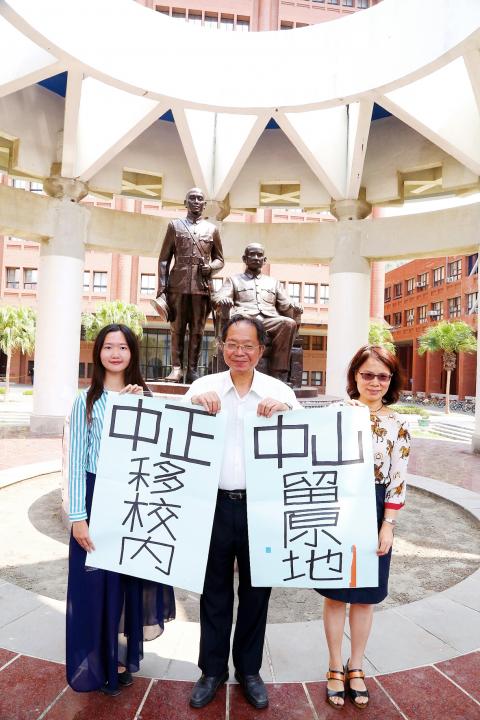National Sun Yat-sen University yesterday announced that its students and faculty have voted to move a statue of Chiang Kai-shek (蔣介石) to a different location on its campus, while a statue of Republic of China founder Sun Yat-sen (孫中山), with which it shares a plinth, is to remain.
The university in November last year initiated a school-wide referendum on whether to move the statues from outside the Info-Library Building.
Online voting for the referendum closed at 4pm on Thursday, with 4,947, or 45.54 percent, of the 10,862 eligible voters casting a ballot, the university’s Office of Student Affairs said in a statement on its Web site.

Photo: Huang Hsu-lei, Taipei Times
Voters could select one of three options for each of the two statues: Keep it where it is; move it to a different location on campus; or move it off campus, the office said.
For Sun’s statue, 3,113 people (62.93 percent) voted to keep it where it is, 871 (17.61 percent) voted to move it to a different location on campus and 963 (19.47 percent) voted to move it off campus, the office said.
For Chiang’s statue, 2,311 people (46.72 percent) voted to keep it where it is, 869 (17.57 percent) voted to move it to a different location on campus and 1,767 (35.72 percent) voted to move it off campus, the office added.
According to the university’s referendum policy, if the “keep it where it is” option received more than 50 percent of the total number of votes, the statue would remain in place, but if it received less than 50 percent of the total number of votes, the statue would be moved.
If the sum of the “keep it where it is” and “move it to a different location on campus” votes exceeded 50 percent of the total number of votes, the statue would be moved to a different location on campus, but if the sum did not exceed 50 percent of the total number of votes, the statue would be moved off campus, the office said.
Based on these rules, Chiang’s statue is to be moved to a different location on campus, the office said.
Details on the time and destination of the move are to be discussed, and the move is to be funded by donations, it added.
The two statues have been repeatedly vandalized on occasions such as 228 Memorial Day.
A student representative surnamed Chien (錢) at a university affairs meeting on Oct. 21, 2016, proposed removing the statues to promote transitional justice, university student association president Yuan Ho-ching (袁禾青) said.
In response to Chien’s proposal, the university’s administration formed an ad hoc committee; for more than a year, the student association, the committee and the Office of Student Affairs hosted a series of debates, she said.
Following the announcement of the referendum result, some university students climbed onto the statues’ pedestal to take photographs.
It was the first time a university or school in Taiwan has resolved the issue of a political figure’s statue through a referendum, the university said in the statement.
It was also the university’s first-ever referendum, it said, adding that it would be delighted to share its experience with other schools.
Additional reporting by CNA

Authorities have detained three former Taiwan Semiconductor Manufacturing Co (TMSC, 台積電) employees on suspicion of compromising classified technology used in making 2-nanometer chips, the Taiwan High Prosecutors’ Office said yesterday. Prosecutors are holding a former TSMC engineer surnamed Chen (陳) and two recently sacked TSMC engineers, including one person surnamed Wu (吳) in detention with restricted communication, following an investigation launched on July 25, a statement said. The announcement came a day after Nikkei Asia reported on the technology theft in an exclusive story, saying TSMC had fired two workers for contravening data rules on advanced chipmaking technology. Two-nanometer wafers are the most

NEW GEAR: On top of the new Tien Kung IV air defense missiles, the military is expected to place orders for a new combat vehicle next year for delivery in 2028 Mass production of Tien Kung IV (Sky Bow IV) missiles is expected to start next year, with plans to order 122 pods, the Ministry of National Defense’s (MND) latest list of regulated military material showed. The document said that the armed forces would obtain 46 pods of the air defense missiles next year and 76 pods the year after that. The Tien Kung IV is designed to intercept cruise missiles and ballistic missiles to an altitude of 70km, compared with the 60km maximum altitude achieved by the Missile Segment Enhancement variant of PAC-3 systems. A defense source said yesterday that the number of

A bipartisan group of US representatives have introduced a draft US-Taiwan Defense Innovation Partnership bill, aimed at accelerating defense technology collaboration between Taiwan and the US in response to ongoing aggression by the Chinese Communist Party (CCP). The bill was introduced by US representatives Zach Nunn and Jill Tokuda, with US House Select Committee on the Chinese Communist Party Chairman John Moolenaar and US Representative Ashley Hinson joining as original cosponsors, a news release issued by Tokuda’s office on Thursday said. The draft bill “directs the US Department of Defense to work directly with Taiwan’s Ministry of National Defense through their respective

Tsunami waves were possible in three areas of Kamchatka in Russia’s Far East, the Russian Ministry for Emergency Services said yesterday after a magnitude 7.0 earthquake hit the nearby Kuril Islands. “The expected wave heights are low, but you must still move away from the shore,” the ministry said on the Telegram messaging app, after the latest seismic activity in the area. However, the Pacific Tsunami Warning System in Hawaii said there was no tsunami warning after the quake. The Russian tsunami alert was later canceled. Overnight, the Krasheninnikov volcano in Kamchatka erupted for the first time in 600 years, Russia’s RIA